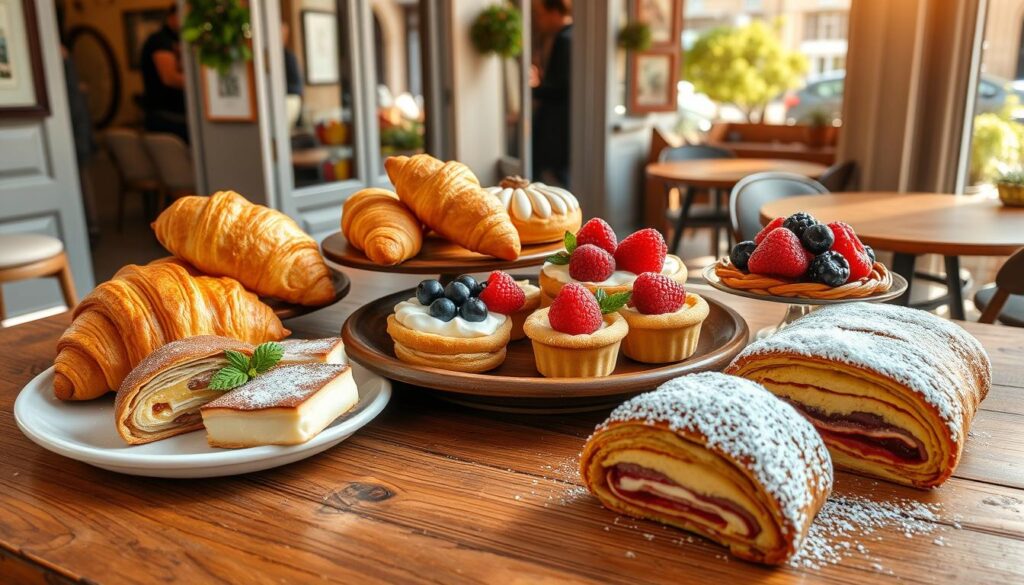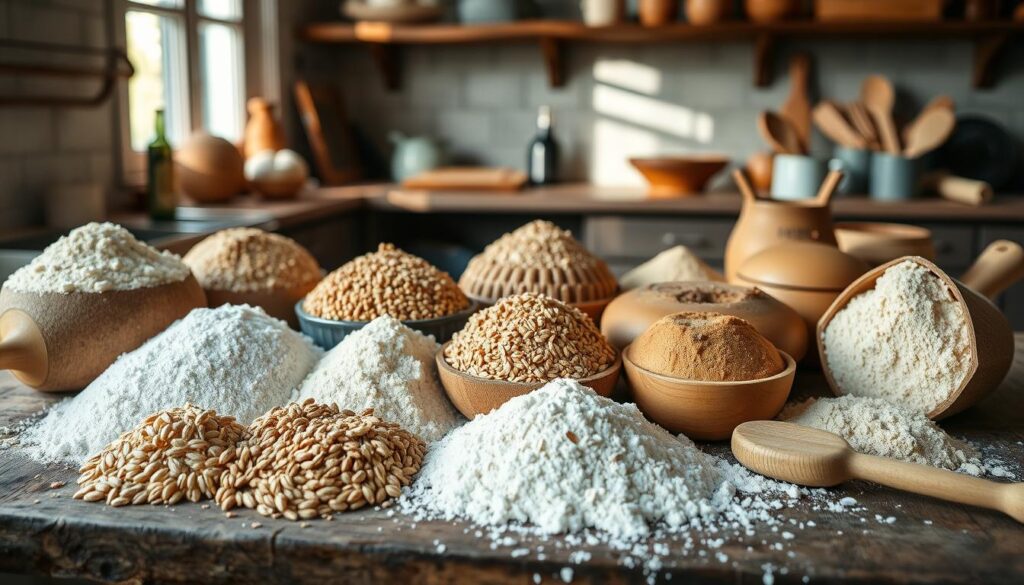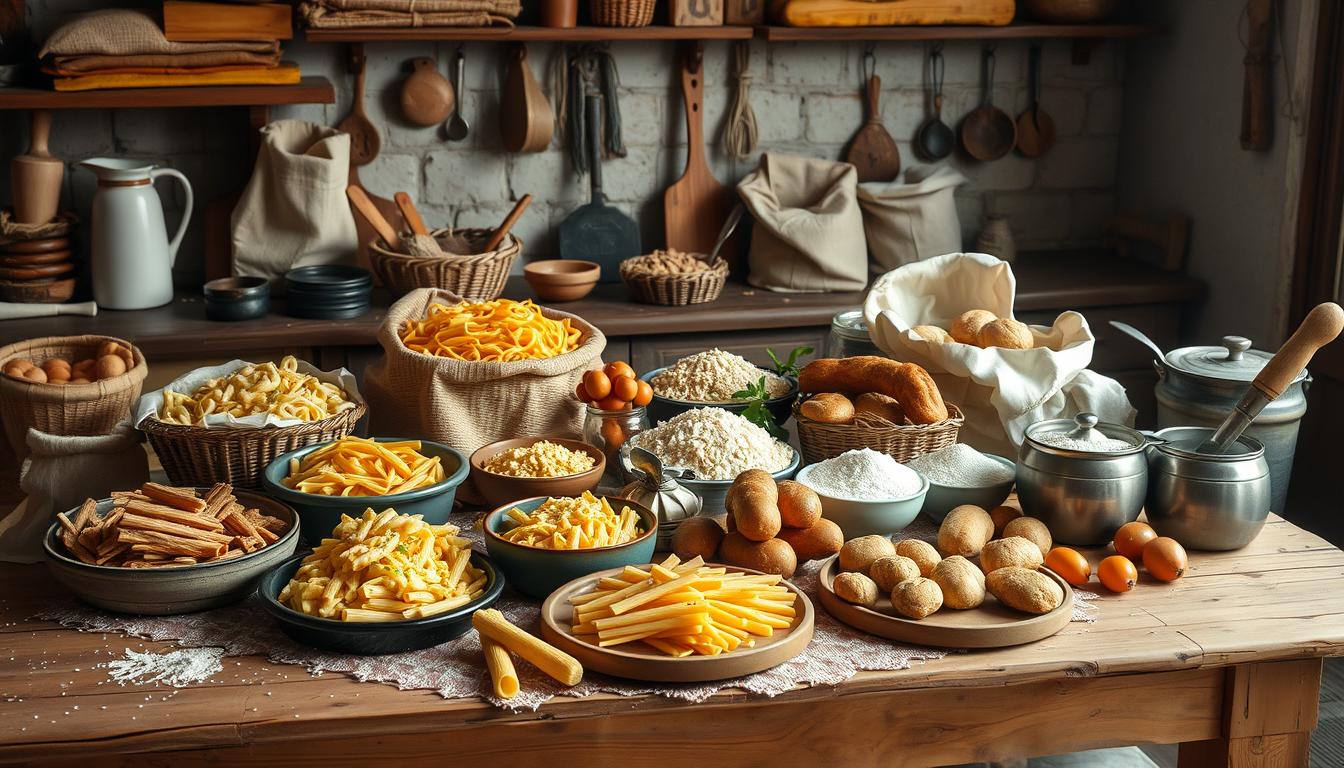I love baking at home and exploring European baking traditions. The smell of fresh bread, the flaky pastry, and the flavors of local dishes excite me. Today, let’s dive into the world of traditional European flour recipes together.
European baking has everything from French crusty bread to Eastern European sweet breads. Whether you’re new to baking or experienced, these recipes can change your cooking. By learning about European flours and old-world baking, we can create amazing dishes at home.
Key Takeaways
- Discover the rich heritage of traditional European baking and flour-based recipes
- Explore diverse European flour varieties and their unique properties
- Master time-honored baking techniques from across the continent
- Create a wide range of European-inspired breads, pastries, and specialty dishes
- Appreciate the cultural traditions and regional specialties that make European baking so captivating
Introduction to Traditional European Baking Heritage
Our European ancestors have built a rich baking tradition over centuries. Each region has its own recipes, techniques, and flours. From France’s rustic loaves to Eastern Europe’s holiday pastries, European baking shows the continent’s vibrant cultures and cuisines.
At the core of this tradition is a love for simple, quality ingredients and old methods. Traditional European bread mixes flour, water, and salt. It’s made by hand and fermented slowly. This gives each loaf its unique taste and texture.
Sweet pastries also play a big role in European baking. Think of Viennese croissants and Austria’s Sachertorte. Holiday treats like Germany’s Stollen and the Czech Republic’s Vanocka show how important baking is in European culture.
“European bread culture embodies tradition, history, community, and family gatherings, serving as more than just a staple food.”
Exploring european baking history, artisan european flours, and old world bakery techniques reveals a world of culinary art, much like the creative variety in our Dessert & Juices collection. Join us as we dive into this timeless tradition.
Essential European Flour Types and Their Uses
Exploring European baking means learning about different flours. Each flour type has its own special qualities. They are key to making classic recipes.
Traditional Wheat Flour Varieties
Europe has many wheat flour types. In Poland, for example, there are flours like “Tortowa” and “Wroclawska”. They have different gluten and protein levels.
This affects how they work in baking. “Poznanska” and “Krupczatka” flours also have unique properties.
Regional Specialty Flours
Europe is also known for specialty flours. Flours like rye, spelt, and semolina add special flavors and textures. They make baked goods unique.
Artisanal Milling Processes
Traditional flour mills use special techniques. Stone grinding keeps grains’ nutrients and flavors intact. This makes flours nutritious and full of taste.
Learning about european flour varieties, artisan european flours, and european flour mills helps us make authentic European baked goods.
| Flour Type | Gluten Content | Protein Content | Ash Content | Typical Uses |
|---|---|---|---|---|
| Type 450 “Tortowa” | ~18% | 9-10% | – | Pastries and Cakes |
| Type 500 “Wroclawska” | ~25% | 10% | 0.50% | Tender Breads |
| Type 500 “Poznanska” | – | ~11% | 0.50% | Pastries and Cakes |
| Type 500 “Krupczatka” | ≥25% | 10-11% | 0.50% | Bread Baking |
| Type 550 “Luksusowa” | ≥25% | 12% | 0.55% | Bread Baking |
| Type 2,000 Whole Wheat | – | ≥15% | 2.00% | Hearty Breads |
“Understanding the diverse array of european flour varieties and the intricacies of european flour mills is key to unlocking the secrets of authentic European baking.”
Classic European Bread Recipes
Explore the rich world of traditional European baking with us. We’ll look at classic European bread recipes. From the crusty French baguettes to the soft Italian focaccia, these recipes show the art of European bread-making traditions.
Discover the secrets of old world bakery techniques. We’ll learn how to make perfect German pretzels and hearty Irish soda bread. These breads may seem simple, but they require skill and the right methods.
Flatbreads are also important in European bread recipes. Pita, naan, and others are cooked on hot surfaces. This gives them a special texture and taste that goes well with many dishes.
Whether you like a crusty outside, soft inside, or chewy crumb, traditional European baking has something for everyone. Try european bread recipes and make your meals more special.
“Bread is the staff of life, the foundation of a good meal, the cornerstone of European cuisine.”
European Flour Recipes for Sweet Pastries
Across Europe, flour-based sweet pastries are a beloved tradition. From Eastern Europe’s rich breads to the delicate treats found everywhere, these recipes show the diversity and art of European baking.
Eastern European Sweet Breads
In Eastern Europe, traditional babka and Hungarian beigli are loved for their buttery dough and sweet fillings. These yeasted breads, often flavored with cinnamon, nuts, and dried fruits, highlight the region’s baking heritage.
Traditional Holiday Pastries
European flour-based pastries are also tied to seasonal celebrations. German stollen, a dense, fruit-studded cake, is a cherished Christmas treat. British hot cross buns, spiced with cinnamon and nutmeg, welcome spring.
Regional Cake Variations
European flour recipes have also led to many regional cake variations. The famous Black Forest cake from Germany combines rich chocolate, cherries, and whipped cream. Italy’s tiramisu mixes coffee-soaked ladyfingers with a creamy mascarpone filling.
These European pastry recipes often combine flour, fruits, nuts, and spices in unique ways. They reflect the diverse culinary heritage of the continent. Whether you prefer Eastern Europe’s comforting flavors or Western Europe’s elegant desserts, there’s a world of flour-based delights to explore.

Mastering Old World Bakery Techniques
We love making authentic European breads at home. To get that old world feel, we use long fermentation, sourdough starters, and special shaping. These methods help us make breads with unique textures and tastes.
The stretch-and-fold method is key for no-knead doughs. It builds gluten gently, making the dough soft and fluffy. This is what makes artisanal breads so special.
Dutch ovens are also vital. They trap steam and heat, just like professional ovens. This makes the crusts crackly and perfect.
Sourdough is a must-try. Making a strong starter takes time, but it’s worth it. A well-made sourdough has deep flavors and a chewy texture.
“The true heart of European baking lies in the mastery of these old world techniques. They’re the foundation for creating breads that are both technically impressive and soulfully satisfying.”
Using these techniques, we can feel like we’re in a European bakery. The smell of fresh bread is amazing. It’s a journey that gives us delicious, authentic breads.
| Technique | Description | Benefits |
|---|---|---|
| Stretch-and-Fold | Gently stretching and folding the dough at regular intervals to develop gluten structure without extensive kneading. | Soft, pillowy crumb texture characteristic of artisanal loaves. |
| Dutch Oven Baking | Using a heavy, lidded pot to replicate the steam-injected environment of professional deck ovens. | Achieves perfectly blistered, crackly crusts that are difficult to attain in a standard home oven. |
| Sourdough Fermentation | Cultivating a robust sourdough starter and allowing for long, slow fermentation. | Develops complex flavors and a chewy texture that are hallmarks of traditional European breads. |
Regional European Specialty Flour Recipes
Our journey through Europe’s flavors takes us to the Mediterranean, Nordic, and Eastern Europe. Each area has its own baking traditions. These traditions show how local flours and cultural tastes come together.
Mediterranean Flour-Based Dishes
In the Mediterranean, we find favorites like Italian focaccia. It’s a soft, savory flatbread made with type 480 flour. In Greece, the pita bread is loved for its soft texture and taste. It’s made with type 550 stronger white flour.
Nordic Baking Traditions
Going north, we meet the hearty rye breads of Scandinavia. The type 720 rye flour gives them a nutty taste and chewy texture. The Swedish Limpa bread is a classic.
The Nordic region also has the Finnish Pulla. It’s a sweet bread with cardamom, made with type 480 universal flour.
Eastern European Specialties
In Eastern Europe, we find many flour-based treats. The Polish bagel and Russian black bread are made with type 750 white bread flour. They show the region’s skill in baking.
The Hungarian Beigli is a sweet roll. It’s made with type 480 universal flour. It’s a treat that shows the love for rich baked goods in Hungary.
| Flour Type | Gluten Content | Protein Content | Ash Content |
|---|---|---|---|
| Universal (Type 480) | 9-10% | Low | – |
| Stronger White (Type 550) | 10-11% | – | – |
| Bread (Type 750) | 12-14% | – | – |
| Rye (Type 720) | Low | – | – |
| Einkorn (Ancient Grain) | Low | High | Much higher |

“The true essence of European baking lies in the delicate mix of local flours and cultural tastes. Each specialty recipe is a mix of flavors, made by the special qualities of these grains.”
Conclusion
Our look into European flour recipes has shown us a world of flavors and textures. These recipes have been perfected over centuries. They help us connect with Europe’s rich culinary past.
By learning about different European flours, we can make real European treats at home. This lets us enjoy the tastes and traditions of Europe.
Each European flour has its own special qualities. From whole wheat to rye, they all add something special to our baking. Using these flours and old baking ways, we can make food that’s full of flavor and texture.
As we finish our look at European baking, we’re excited to keep trying new recipes. Sharing these traditions helps keep European baking alive for future generations.

